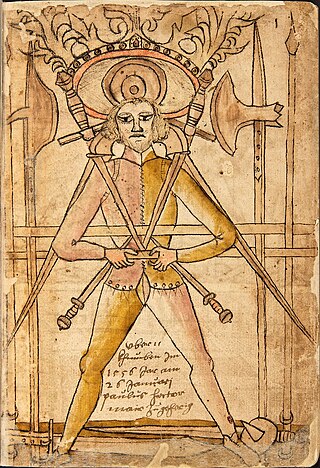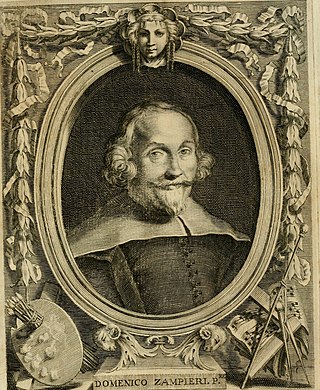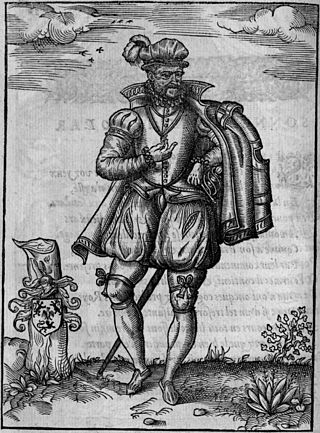Related Research Articles

A rapier or espada ropera is a type of sword originally used in Spain and Italy. The name designates a sword with a straight, slender and sharply pointed two-edged long blade wielded in one hand. It was widely popular in Western Europe throughout the 16th and 17th centuries as a symbol of nobility or gentleman status.

Historical European martial arts (HEMA) are martial arts of European origin, particularly using arts formerly practised, but having since died out or evolved into very different forms.
Martial arts manuals are instructions, with or without illustrations, specifically designed to be learnt from a book. Many books detailing specific techniques of martial arts are often erroneously called manuals but were written as treatises.

Domenico Zampieri, known by the diminutive Domenichino after his shortness, was an Italian Baroque painter of the Bolognese School of painters.

The term Italian school of swordsmanship is used to describe the Italian style of fencing and edged-weapon combat from the time of the first extant Italian swordsmanship treatise (1409) to the days of classical fencing.
Achille Marozzo (1484–1553) was an Italian fencing master, one of the most important teachers in the Dardi or Bolognese tradition.

The known history of fencing in France begins in the 16th century, with the adoption of Italian styles of fencing.
Giovanni Girolamo Kapsperger was an Austrian-Italian virtuoso performer and composer of the early Baroque period. A prolific and highly original composer, Kapsberger is chiefly remembered today for his lute and theorbo (chitarrone) music, which was seminal in the development of these as solo instruments.
Bolognese Swordsmanship, also sometimes known as the Dardi school, is a tradition within the Italian school of swordsmanship which is based on the surviving fencing treatises published by several 16th century fencing masters of Bologna, As early as the 14th century several fencing masters were living and teaching in the city: a maestro Rosolino in 1338, a maestro Nerio in 1354, and a maestro Francesco in 1385.
The decade of the 1530s in music involved some significant events, publications, compositions, births, and deaths.

The Diocese of Perpignan–Elne is a Latin diocese of the Catholic Church in France. The diocese comprises the Department of Pyrénées-Orientales. This see continues the old Diocese of Elne, which was renamed and had its see relocated at Perpignan, in 1601 after a papal bull of Pope Clement VIII. Its territory brought together the Diocese of Elne, part of the Spanish Diocese of Urgel known as French Cerdagne, three cantons of the Diocese of Alet, and two villages of the Diocese of Narbonne.
The oldest surviving manual on western swordsmanship dates back to the 14th century, although historical references date fencing schools back to the 12th century.

GérardThibault of Antwerp was a fencing master and writer of the 1628 rapier manual Academie de l'Espée. Thibault was from the Southern Netherlands which is today Belgium. His manual is one of the most detailed and elaborate extant sources on rapier combat, painstakingly utilizing geometry and logic to defend his unorthodox style of swordsmanship.
Jean Nicolas Grou was a French Roman Catholic Jesuit priest, teacher, translator and mystic and spiritual writer. After the suppression of the Jesuit order, he sought sanctuary in the Dutch Republic. He returned to France, but at the outbreak of the French Revolution, he escaped to England where he gained refuge with a wealthy English household in Dorset whose house chaplain he became while continuing his literary output.
The Chicago Swordplay Guild is a modern school of swordsmanship and Western martial arts, and non-profit organization based in Chicago, Illinois, United States. It provides organized instruction in the study and practice of historical European swordplay, with a principal focus on the Italian school of swordsmanship and other martial arts of the 14th–17th centuries. Co-founded in 1999 by Gregory Mele and Mark Rector, the Chicago Swordplay Guild seeks to be consistent with the methodology of the ancient European fencing schools by combining scholarship and research into the teachings of the historical Masters, with the practical knowledge gained through solo and partnered drilling and fencing. Since techniques are taught in reference to how effective they would be in a real encounter, the Guild practices with an absolute emphasis on safety, control, competence, and skill at arms.

Hieronymus Galle or Hieronymus Galle I or the Elder was a Flemish painter, who specialized in still lifes of fruit and flowers and hunting pieces. He collaborated with his fellow painters on garland paintings, i.e. paintings showing a garland of flowers or fruit around a devotional image or portrait.
François Dancie was a French fencing instructor who wrote two treaties in the seventeenth century. He was a gentleman of Limousin in central France. He may be François Dancie of Nonards, recorded as marrying Jeanne de Linnars, daughter of Jacques de Linnars, Judge of Bretenaux. Jeanne's brother Jean was married to Marie de Maynard, daughter of Géraud de Maynard, counsellor to the Parlement of Toulouse, and also sister to the poet François de Maynard, who wrote a poem for Dancie's publication of 1623.

The Renaissance Sword Club is a historical European martial arts group based in London, South East of England and Brittany, France. It was founded in 2013 by Rob Runacres. Its primary aim is the research and recreation of European swordsmanship of the sixteenth and seventeenth centuries, specifically those concerned with the rapier and spada da lato, as well as their companion weapons such as the dagger, cloak, buckler and rotella. Members have also pursued interests outside of the core curriculum in to staff weapons, longsword and small sword.

Masters of Defence or Masters of Fencing is a widespread guild of teachers specializing in close combat military techniques with weapons, civilian fighting skills, and unarmed combat. The title was coined during the medieval period, and referred to men who were particularly skilled at the art of fighting.

Libro de las grandezas de la espada is a 16th-century Spanish treatise on fencing written by Don Luis Pacheco de Narváez, who is considered one of the founding fathers of Spanish fencing (destreza) and the disciple of Jerónimo Sánchez de Carranza.
References
- ↑ [Castle, E. Egerton Schools and Masters of Fencing: From the Middle Ages to the Eighteenth Century, 2003, p.105]
- ↑ [Briorst P., Drevillon H. & Serna P, Croiser le fer: Violence et culture de l'épée dans la France modern, 2002 p.66]
- ↑ [Brantome, Discours sur les duels, 1997, p.199]
- ↑ [Héroard, Jean, Journal de Jean Héroard sur l'enfance et la jeunesse de Louis XIII (1601-1628)]